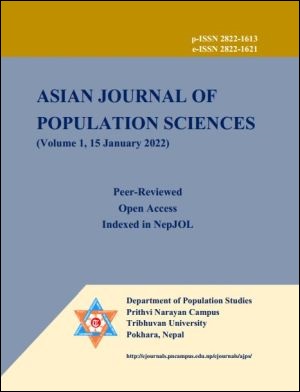Prevalence and Some Correlates of Child Marriage in Kapilbastu District, Nepal
DOI:
https://doi.org/10.3126/ajps.v1i1.43591Keywords:
Child marriage, early marriage, age at first marriage, young people (10-14 years), before age 20, before age 18Abstract
The study was carried out to examine the prevalence of child marriage before ages 20 and 18, some correlates of early marriage and prevalence of early birth as its consequence in Kapilbastu district, Nepal. The correlates of child marriage of young people (10-24 years), especially that of females were examined with some selected variables like caste/ethnicity, wealth status of household, rural-urban place of residence and education of young females. The study has used the data files of Child Marriage Baseline Survey 2016. The findings of the study are presented in percentages in cross tabulations and charts and significance of data is tested using chi-square with degrees of freedom from the contingency tables of frequency distribution at p≤0.001, p≤0.01 and p≤0.05 levels. The study found significantly higher proportion of young females than males marrying for the first time before ages 20 (23.6% vs. 9.6%, p<0.001) and 18 (16.6% vs. 5.9%, p<0.001). The prevalence of girl's marriage before age 20 is higher among certain caste/ethnic groups like ‘other’ category (36.8%), Dalits (31.9%), Terai/Madheshi (29.6%) castes. The findings are also significant at p<0.001 from the contingency table of frequency distribution according to caste/ethnicity. More females living in the rural area than in urban were marred before ages 20 (26% vs. 19%) and 18 (19.8% vs. 10.3%). However, the data is not found significant at p=0.05 level. Similarly, the association between wealth status of household and early marriage was also not found significant at p=0.05 level. There is found negative association between age at first marriage of young females and level of their education, except for primary level of education, as the proportions of young females marrying before ages 20 and 18 declined with the increased level of education from no formal education (40.5% and 29.7% respectively) to secondary level (26.1% and 20.7% respectively) to higher than secondary level (15.1% and 1.9% respectively). The results are also significant at p<0.001 level. The major and immediate consequences of early marriage are early pregnancy and childbirth. More than one-third females aged 20-24 years who married before 18 years of age, had given birth to a child before age 20 and one-in-ten had a birth within the first year of marriage.
Downloads
Downloads
Published
How to Cite
Issue
Section
License
Copyright (c) 2022 Dhanendra Veer Shakya

This work is licensed under a Creative Commons Attribution-ShareAlike 4.0 International License.




